engine CHRYSLER VOYAGER 2000 Diagnostic Manual
[x] Cancel search | Manufacturer: CHRYSLER, Model Year: 2000, Model line: VOYAGER, Model: CHRYSLER VOYAGER 2000Pages: 364, PDF Size: 2.17 MB
Page 3 of 364
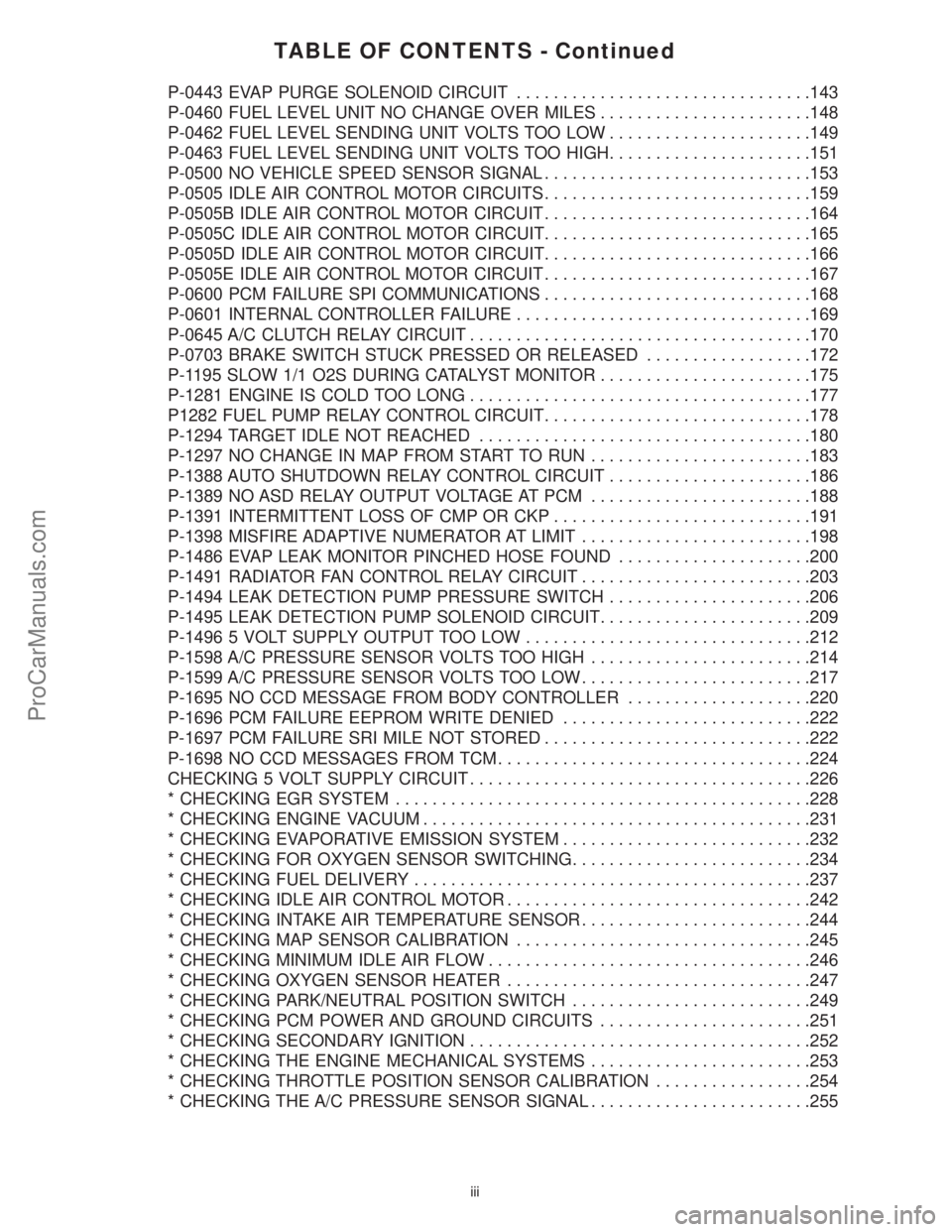
TABLE OF CONTENTS - Continued
P-0443 EVAP PURGE SOLENOID CIRCUIT................................143
P-0460 FUEL LEVEL UNIT NO CHANGE OVER MILES.......................148
P-0462 FUEL LEVEL SENDING UNIT VOLTS TOO LOW......................149
P-0463 FUEL LEVEL SENDING UNIT VOLTS TOO HIGH......................151
P-0500 NO VEHICLE SPEED SENSOR SIGNAL.............................153
P-0505 IDLE AIR CONTROL MOTOR CIRCUITS.............................159
P-0505B IDLE AIR CONTROL MOTOR CIRCUIT.............................164
P-0505C IDLE AIR CONTROL MOTOR CIRCUIT.............................165
P-0505D IDLE AIR CONTROL MOTOR CIRCUIT.............................166
P-0505E IDLE AIR CONTROL MOTOR CIRCUIT.............................167
P-0600 PCM FAILURE SPI COMMUNICATIONS.............................168
P-0601 INTERNAL CONTROLLER FAILURE................................169
P-0645 A/C CLUTCH RELAY CIRCUIT.....................................170
P-0703 BRAKE SWITCH STUCK PRESSED OR RELEASED..................172
P-1195 SLOW 1/1 O2S DURING CATALYST MONITOR.......................175
P-1281 ENGINE IS COLD TOO LONG.....................................177
P1282 FUEL PUMP RELAY CONTROL CIRCUIT.............................178
P-1294 TARGET IDLE NOT REACHED....................................180
P-1297 NO CHANGE IN MAP FROM START TO RUN........................183
P-1388 AUTO SHUTDOWN RELAY CONTROL CIRCUIT......................186
P-1389 NO ASD RELAY OUTPUT VOLTAGE AT PCM........................188
P-1391 INTERMITTENT LOSS OF CMP OR CKP............................191
P-1398 MISFIRE ADAPTIVE NUMERATOR AT LIMIT.........................198
P-1486 EVAP LEAK MONITOR PINCHED HOSE FOUND.....................200
P-1491 RADIATOR FAN CONTROL RELAY CIRCUIT.........................203
P-1494 LEAK DETECTION PUMP PRESSURE SWITCH......................206
P-1495 LEAK DETECTION PUMP SOLENOID CIRCUIT.......................209
P-1496 5 VOLT SUPPLY OUTPUT TOO LOW...............................212
P-1598 A/C PRESSURE SENSOR VOLTS TOO HIGH........................214
P-1599 A/C PRESSURE SENSOR VOLTS TOO LOW.........................217
P-1695 NO CCD MESSAGE FROM BODY CONTROLLER....................220
P-1696 PCM FAILURE EEPROM WRITE DENIED...........................222
P-1697 PCM FAILURE SRI MILE NOT STORED.............................222
P-1698 NO CCD MESSAGES FROM TCM..................................224
CHECKING 5 VOLT SUPPLY CIRCUIT.....................................226
* CHECKING EGR SYSTEM.............................................228
* CHECKING ENGINE VACUUM..........................................231
* CHECKING EVAPORATIVE EMISSION SYSTEM...........................232
* CHECKING FOR OXYGEN SENSOR SWITCHING..........................234
* CHECKING FUEL DELIVERY...........................................237
* CHECKING IDLE AIR CONTROL MOTOR.................................242
* CHECKING INTAKE AIR TEMPERATURE SENSOR.........................244
* CHECKING MAP SENSOR CALIBRATION................................245
* CHECKING MINIMUM IDLE AIR FLOW...................................246
* CHECKING OXYGEN SENSOR HEATER.................................247
* CHECKING PARK/NEUTRAL POSITION SWITCH..........................249
* CHECKING PCM POWER AND GROUND CIRCUITS.......................251
* CHECKING SECONDARY IGNITION.....................................252
* CHECKING THE ENGINE MECHANICAL SYSTEMS........................253
* CHECKING THROTTLE POSITION SENSOR CALIBRATION.................254
* CHECKING THE A/C PRESSURE SENSOR SIGNAL........................255
iii
ProCarManuals.com
Page 4 of 364

TABLE OF CONTENTS - Continued
SPEED CONTROL
P-1595 SPEED CONTROL SOLENOID CIRCUITS...........................256
P-1683 SPEED CONTROL POWER RELAY OR S/C 12V DRIVER..............256
SPEED CONTROL BRAKE SWITCH OUTPUT..............................261
SPEED CONTROL DENIED MESSAGE....................................263
SPEED CONTROL ON/OFF SWITCH......................................264
* CHECKING SPEED CONTROL OPERATION..............................266
STARTING
*9NO RESPONSE9CONDITION..........................................272
* CHECKING THE CAM AND CRANK SENSORS............................276
* CHECKING THE ENGINE MECHANICAL SYSTEMS........................277
* CHECKING THE FUEL SYSTEM........................................278
* CHECKING THE IDLE AIR CONTROL MOTOR.............................287
* CHECKING THE SECONDARY IGNITION SYSTEM.........................288
* NO CRANK CONDITION...............................................296
* START AND STALL CONDITION.........................................301
TRANSMISSION
P-0740 TORQUE CONV CLUTCH, NO RPM DROP AT LOCKUP...............302
P-0743 TORQUE CONVERTER CLUTCH SOLENOID CIRCUIT................304
P-1899 PARK/NEUTRAL SWITCH STUCK IN PARK OR IN GEAR..............307
ANTENNA FAILURE....................................................310
COP FAILURE.........................................................310
EEPROM FAILURE.....................................................310
INTERNAL FAULTS.....................................................310
RAM FAILURE.........................................................310
SERIAL LINK INTERNAL................................................310
STACK OVERFLOW FAILURE............................................310
SENTRY KEY IMMOBILIZER SYSTEM
PCM STATUS FAILURE.................................................311
ROLLING CODE FAILURE...............................................311
SERIAL LINK EXTERNAL FAULT..........................................311
TRANSPONDER COMMUNICATION FAILURE..............................313
TRANSPONDER ID MISMATCH..........................................313
TRANSPONDER RESPONSE MISMATCH..................................313
VIN MISMATCH........................................................315
VERIFICATION TESTS
VERIFICATION TESTS..................................................317
8.0 COMPONENT LOCATIONS..............................................323
8.1CONTROL MODULES AND PDC.....................................323
8.2CONTROLS & SOLENOIDS.........................................323
8.3DATA LINK CONNECTOR..........................................327
8.4SENSORS.......................................................327
8.5FUEL SYSTEM...................................................330
8.6SWITCHES......................................................331
8.7SPECIFICATIONS.................................................332
iv
ProCarManuals.com
Page 5 of 364
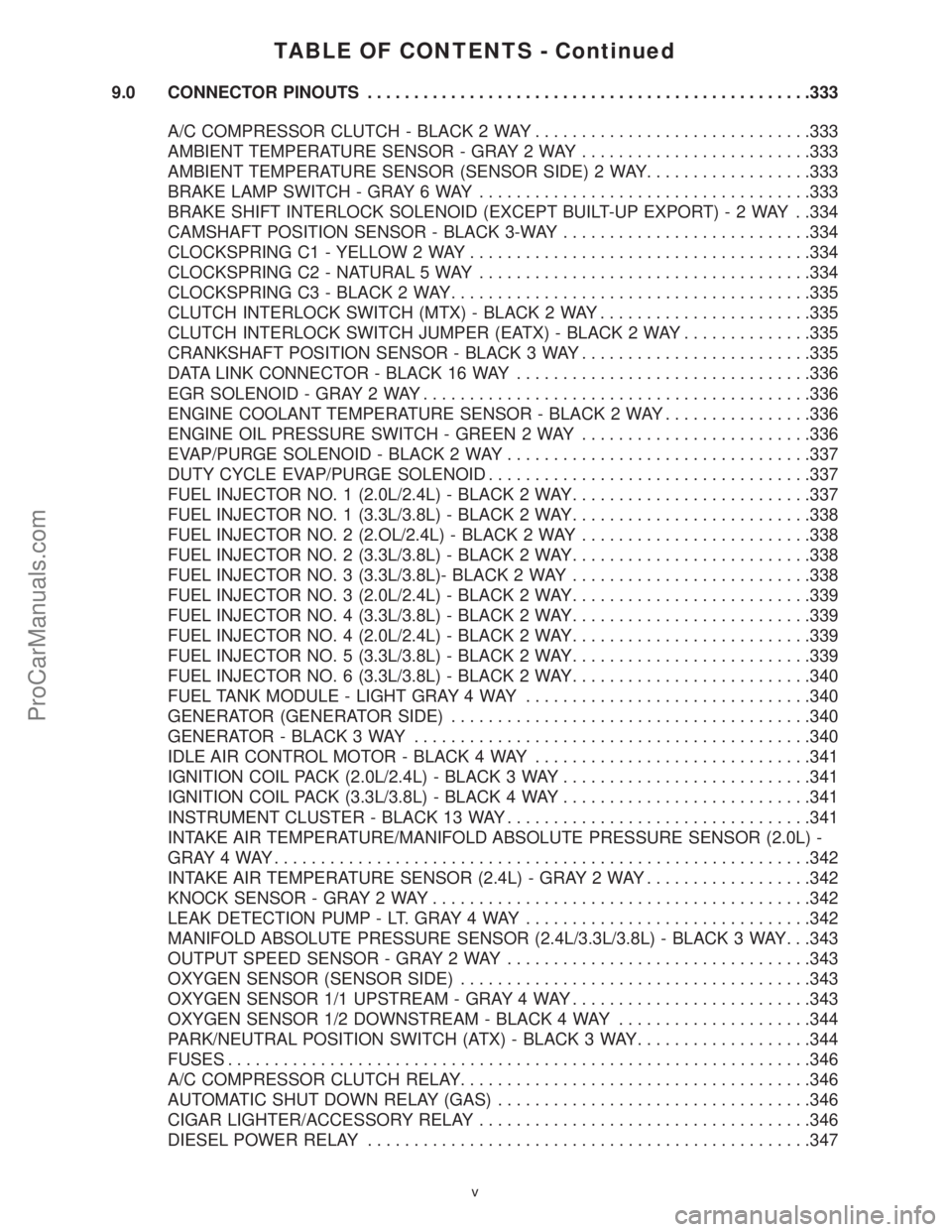
TABLE OF CONTENTS - Continued
9.0 CONNECTOR PINOUTS................................................333
A/C COMPRESSOR CLUTCH - BLACK 2 WAY..............................333
AMBIENT TEMPERATURE SENSOR - GRAY 2 WAY.........................333
AMBIENT TEMPERATURE SENSOR (SENSOR SIDE) 2 WAY..................333
BRAKE LAMP SWITCH - GRAY 6 WAY....................................333
BRAKE SHIFT INTERLOCK SOLENOID (EXCEPT BUILT-UP EXPORT)-2WAY ..334
CAMSHAFT POSITION SENSOR - BLACK 3-WAY...........................334
CLOCKSPRING C1 - YELLOW 2 WAY.....................................334
CLOCKSPRING C2 - NATURAL 5 WAY....................................334
CLOCKSPRING C3 - BLACK 2 WAY.......................................335
CLUTCH INTERLOCK SWITCH (MTX) - BLACK 2 WAY.......................335
CLUTCH INTERLOCK SWITCH JUMPER (EATX) - BLACK 2 WAY..............335
CRANKSHAFT POSITION SENSOR - BLACK 3 WAY.........................335
DATA LINK CONNECTOR - BLACK 16 WAY................................336
EGR SOLENOID - GRAY 2 WAY..........................................336
ENGINE COOLANT TEMPERATURE SENSOR - BLACK 2 WAY................336
ENGINE OIL PRESSURE SWITCH - GREEN 2 WAY.........................336
EVAP/PURGE SOLENOID - BLACK 2 WAY.................................337
DUTY CYCLE EVAP/PURGE SOLENOID...................................337
FUEL INJECTOR NO. 1 (2.0L/2.4L) - BLACK 2 WAY..........................337
FUEL INJECTOR NO. 1 (3.3L/3.8L) - BLACK 2 WAY..........................338
FUEL INJECTOR NO. 2 (2.OL/2.4L) - BLACK 2 WAY.........................338
FUEL INJECTOR NO. 2 (3.3L/3.8L) - BLACK 2 WAY..........................338
FUEL INJECTOR NO. 3 (3.3L/3.8L)- BLACK 2 WAY..........................338
FUEL INJECTOR NO. 3 (2.0L/2.4L) - BLACK 2 WAY..........................339
FUEL INJECTOR NO. 4 (3.3L/3.8L) - BLACK 2 WAY..........................339
FUEL INJECTOR NO. 4 (2.0L/2.4L) - BLACK 2 WAY..........................339
FUEL INJECTOR NO. 5 (3.3L/3.8L) - BLACK 2 WAY..........................339
FUEL INJECTOR NO. 6 (3.3L/3.8L) - BLACK 2 WAY..........................340
FUEL TANK MODULE - LIGHT GRAY 4 WAY...............................340
GENERATOR (GENERATOR SIDE).......................................340
GENERATOR - BLACK 3 WAY...........................................340
IDLE AIR CONTROL MOTOR - BLACK 4 WAY..............................341
IGNITION COIL PACK (2.0L/2.4L) - BLACK 3 WAY...........................341
IGNITION COIL PACK (3.3L/3.8L) - BLACK 4 WAY...........................341
INSTRUMENT CLUSTER - BLACK 13 WAY.................................341
INTAKE AIR TEMPERATURE/MANIFOLD ABSOLUTE PRESSURE SENSOR (2.0L) -
GRAY4 WAY..........................................................342
INTAKE AIR TEMPERATURE SENSOR (2.4L) - GRAY 2 WAY..................342
KNOCK SENSOR - GRAY 2 WAY.........................................342
LEAK DETECTION PUMP - LT. GRAY 4 WAY...............................342
MANIFOLD ABSOLUTE PRESSURE SENSOR (2.4L/3.3L/3.8L) - BLACK 3 WAY. . .343
OUTPUT SPEED SENSOR - GRAY 2 WAY.................................343
OXYGEN SENSOR (SENSOR SIDE)......................................343
OXYGEN SENSOR 1/1 UPSTREAM - GRAY 4 WAY..........................343
OXYGEN SENSOR 1/2 DOWNSTREAM - BLACK 4 WAY.....................344
PARK/NEUTRAL POSITION SWITCH (ATX) - BLACK 3 WAY...................344
FUSES...............................................................346
A/C COMPRESSOR CLUTCH RELAY......................................346
AUTOMATIC SHUT DOWN RELAY (GAS)..................................346
CIGAR LIGHTER/ACCESSORY RELAY....................................346
DIESEL POWER RELAY................................................347
v
ProCarManuals.com
Page 6 of 364
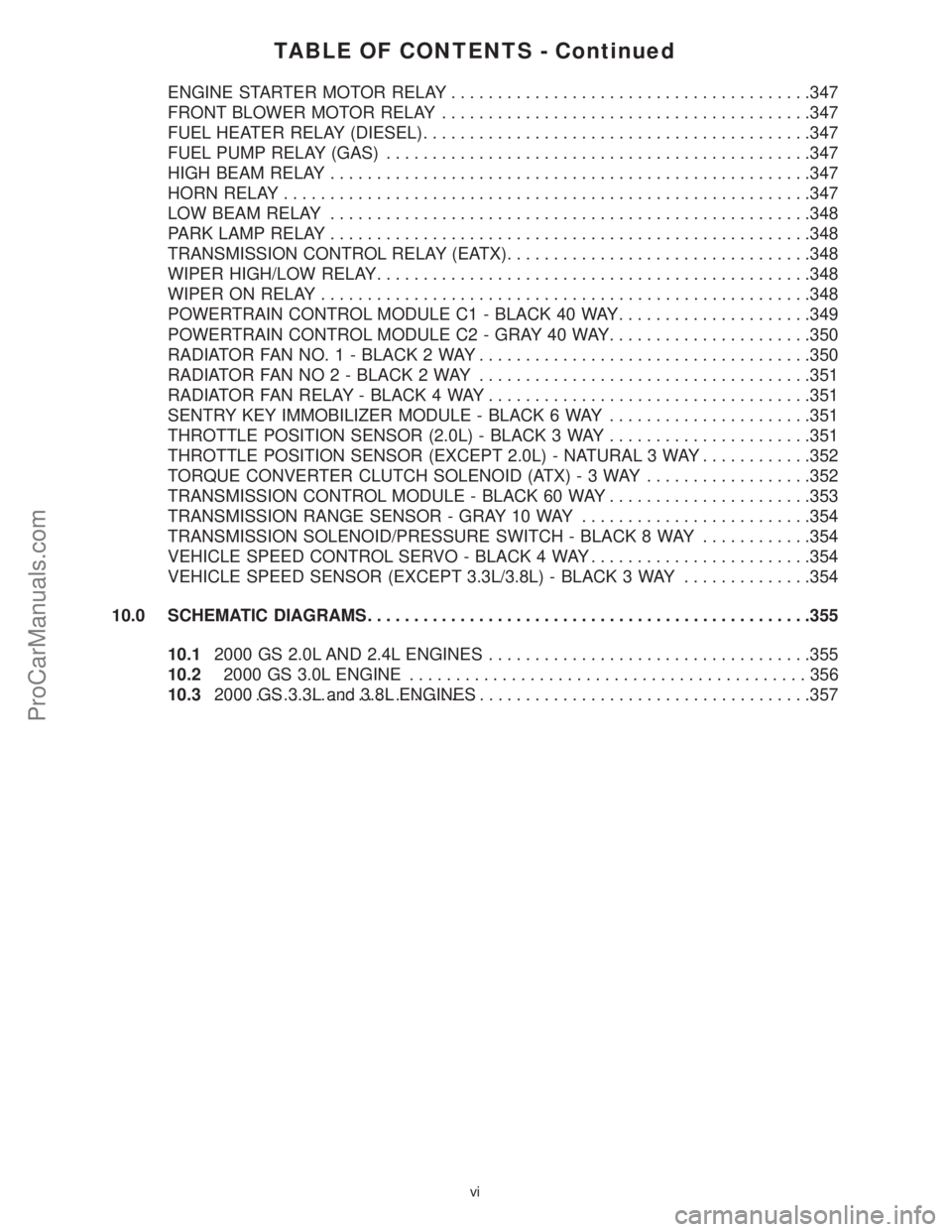
TABLE OF CONTENTS - Continued
ENGINE STARTER MOTOR RELAY.......................................347
FRONT BLOWER MOTOR RELAY........................................347
FUEL HEATER RELAY (DIESEL)..........................................347
FUEL PUMP RELAY (GAS)..............................................347
HIGH BEAM RELAY....................................................347
HORN RELAY.........................................................347
LOW BEAM RELAY....................................................348
PARK LAMP RELAY....................................................348
TRANSMISSION CONTROL RELAY (EATX).................................348
WIPER HIGH/LOW RELAY...............................................348
WIPER ON RELAY.....................................................348
POWERTRAIN CONTROL MODULE C1 - BLACK 40 WAY.....................349
POWERTRAIN CONTROL MODULE C2 - GRAY 40 WAY......................350
RADIATOR FAN NO. 1 - BLACK 2 WAY....................................350
RADIATOR FAN NO 2 - BLACK 2 WAY....................................351
RADIATOR FAN RELAY - BLACK 4 WAY...................................351
SENTRY KEY IMMOBILIZER MODULE - BLACK 6 WAY......................351
THROTTLE POSITION SENSOR (2.0L) - BLACK 3 WAY......................351
THROTTLE POSITION SENSOR (EXCEPT 2.0L) - NATURAL 3 WAY............352
TORQUE CONVERTER CLUTCH SOLENOID (ATX)-3WAY..................352
TRANSMISSION CONTROL MODULE - BLACK 60 WAY......................353
TRANSMISSION RANGE SENSOR - GRAY 10 WAY.........................354
TRANSMISSION SOLENOID/PRESSURE SWITCH - BLACK 8 WAY............354
VEHICLE SPEED CONTROL SERVO - BLACK 4 WAY........................354
VEHICLE SPEED SENSOR (EXCEPT 3.3L/3.8L) - BLACK 3 WAY..............354
10.0 SCHEMATIC DIAGRAMS................................................355
10.12000 GS 2.0L AND 2.4L ENGINES...................................355
10.22000 GS 3.0L ENGINE...........................................356
10.32000 GS 3.3L and 3.8L ENGINES................................................................357
vi
ProCarManuals.com
Page 7 of 364

1.0 INTRODUCTION
The procedures contained in this manual include
specifications, instructions, and graphics needed to
diagnose the PCM Powertrain System. The diag-
nostics in this manual are based on the failure
condition or symptom being present at time of
diagnosis.
Please follow the recommendations below when
choosing your diagnostic path.
1. First make sure the DRBIIItis communicating
with the appropriate modules; ie., if the DRBIIIt
displays a ``No Response'' condition, you must
diagnose this first before proceeding.
2. Read DTC's (diagnostic trouble codes) with the
DRBIIIt.
3. If no DTC's are present, identify the customer
complaint.
4. Once the DTC or customer complaint is identi-
fied, locate the matching test in the Table of
Contents and begin to diagnose the symptom.
All component location views are in Section 8.0.
All connector pinouts are in Section 9.0. All system
schematics are in Section 10.0.
An * placed before the symptom description indi-
cates a customer complaint.
When repairs are required, refer to the appropri-
ate service manual for the proper removal and
repair procedure.
Diagnostic procedures change every year. New
diagnostic systems may be added; carryover sys-
tems may be enhanced. READ THIS MANUAL
BEFORE TRYING TO DIAGNOSE A VEHICLE
CODE. It is recommended that you review the
entire manual to become familiar with all new and
changed diagnostic procedures.
After using this book, if you have any comments
or recommendations, please fill out the form at the
back of the book and mail it back to us.
1.1 SYSTEM COVERAGE
This diagnostic procedures manual covers the
following 2000 Chrysler Caravan Voyager vehicles
equipped with the 2.0L, 2.4L DOHC, 3.0L MPI,
3.3L/3.8L MPI, or 3.3L E85 compatible Engine.
1.2 SIX-STEP TROUBLESHOOTING
PROCEDURE
Diagnosis of the powertrain control module
(PCM) is done in six basic steps:
²verification of complaint
²verification of any related symptoms
²symptom analysis
²problem isolation
²repair of isolated problem
²verification of proper operation
2.0 IDENTIFICATION OF
SYSTEM
The Powertrain Control Module (PCM) monitors
and controls:
²Fuel system
²Ignition system
²charging system
²speed control system
²cooling system
3.0 SYSTEM DESCRIPTION AND
FUNCTIONAL OPERATION
3.1 GENERAL DESCRIPTION
These Sequential Fuel Injection (SFI) engine sys-
tems have the latest in technical advances. The
on-board Euro Stage III On-Board Diagnostic incor-
porated with the powertrain control module (PCM)
are intended to assist the field technician in repair-
ing vehicle problems by the quickest means.
3.2 FUNCTION OPERATION
3.2.1 FUEL CONTROL
The PCM controls the air/fuel ratio of the engine
by varying fuel injector on time. Mass air flow is
calculated using the speed density method using
engine speed, manifold absolute pressure, and air
temperature change.
Different fuel calculation strategies are used de-
pendent on the operational state of the engine.
During crank mode, a prime shot fuel pulse is
delivered followed by fuel pulses determined by a
crank time strategy. Cold engine operation is deter-
mined via an open loop strategy until the O2
sensors have reached operating temperature. At
this point, the strategy enters a closed loop mode
where fuel requirements are based upon the state of
the O2 sensors, engine speed, MAP, throttle posi-
tion, air temperature, battery voltage, and coolant
temperature.
1
GENERAL INFORMATION
ProCarManuals.com
Page 8 of 364

3.2.2 ON-BOARD DIAGNOSTICS
The PCM has been programmed to monitor many
different circuits of the fuel injection system. This
monitoring is called ªon-board diagnosis.º
Certain criteria, or ªarming conditions,º must be
met for a trouble code to be entered into the PCM
memory. The criteria may be a range of: engine rpm,
engine temperature, and/or input voltage to the
PCM. If a problem is sensed with a monitored
circuit, and all of the criteria or arming conditions
are met, then a trouble code will be stored in the
PCM.
It is possible that a trouble code for a monitored
circuit may not be entered into the PCM memory
even though a malfunction has occurred. This mayhappen because one of the trouble code criteria
(arming conditions) have not been met.
The PCM compares input signal voltages from
each input device with specifications (the estab-
lished high and low limits of the range) that are
programmed into it for that device. If the input
voltage is not within specifications and other trou-
ble code criteria (arming conditions) are met, a
trouble code will be stored in the PCM memory.
The On Board Diagnostics have evolved to the
second Generation of Diagnostics referred to as
Euro Stage III On-Board Diagnostic.
The following table summarizes the various
OBDII monitors operation.
2
GENERAL INFORMATION
ProCarManuals.com
Page 9 of 364
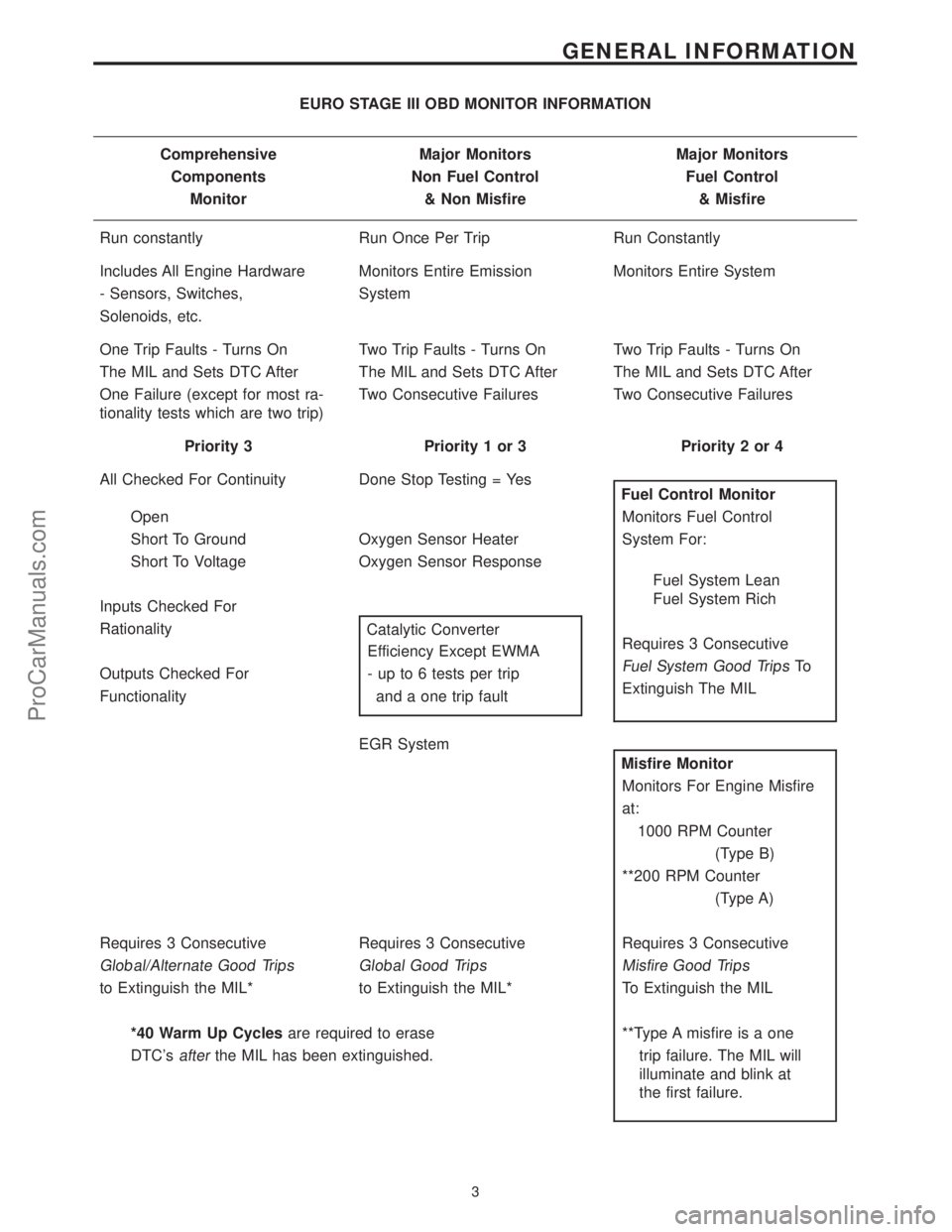
EURO STAGE III OBD MONITOR INFORMATION
Comprehensive Major Monitors Major Monitors
Components Non Fuel Control Fuel Control
Monitor & Non Misfire & Misfire
Run constantly Run Once Per Trip Run Constantly
Includes All Engine Hardware Monitors Entire Emission Monitors Entire System
- Sensors, Switches, System
Solenoids, etc.
One Trip Faults - Turns On Two Trip Faults - Turns On Two Trip Faults - Turns On
The MIL and Sets DTC After The MIL and Sets DTC After The MIL and Sets DTC After
One Failure (except for most ra-
tionality tests which are two trip)Two Consecutive Failures Two Consecutive Failures
Priority 3 Priority 1 or 3 Priority 2 or 4
All Checked For Continuity Done Stop Testing = Yes
Fuel Control Monitor
Open Monitors Fuel Control
Short To Ground Oxygen Sensor Heater System For:
Short To Voltage Oxygen Sensor Response
Fuel System Lean
Fuel System Rich
Inputs Checked For
Requires 3 Consecutive Rationality
Catalytic Converter
Fuel System Good TripsTo Efficiency Except EWMA
Extinguish The MIL Outputs Checked For - up to 6 tests per trip
Functionality and a one trip fault
EGR System
Misfire Monitor
Monitors For Engine Misfire
at:
1000 RPM Counter
(Type B)
**200 RPM Counter
(Type A)
Requires 3 Consecutive Requires 3 Consecutive Requires 3 Consecutive
Global/Alternate Good Trips Global Good Trips Misfire Good Trips
to Extinguish the MIL* to Extinguish the MIL* To Extinguish the MIL
*40 Warm Up Cyclesare required to erase **Type A misfire is a one
DTC's
afterthe MIL has been extinguished. trip failure. The MIL will
illuminate and blink at
the first failure.
3
GENERAL INFORMATION
ProCarManuals.com
Page 10 of 364
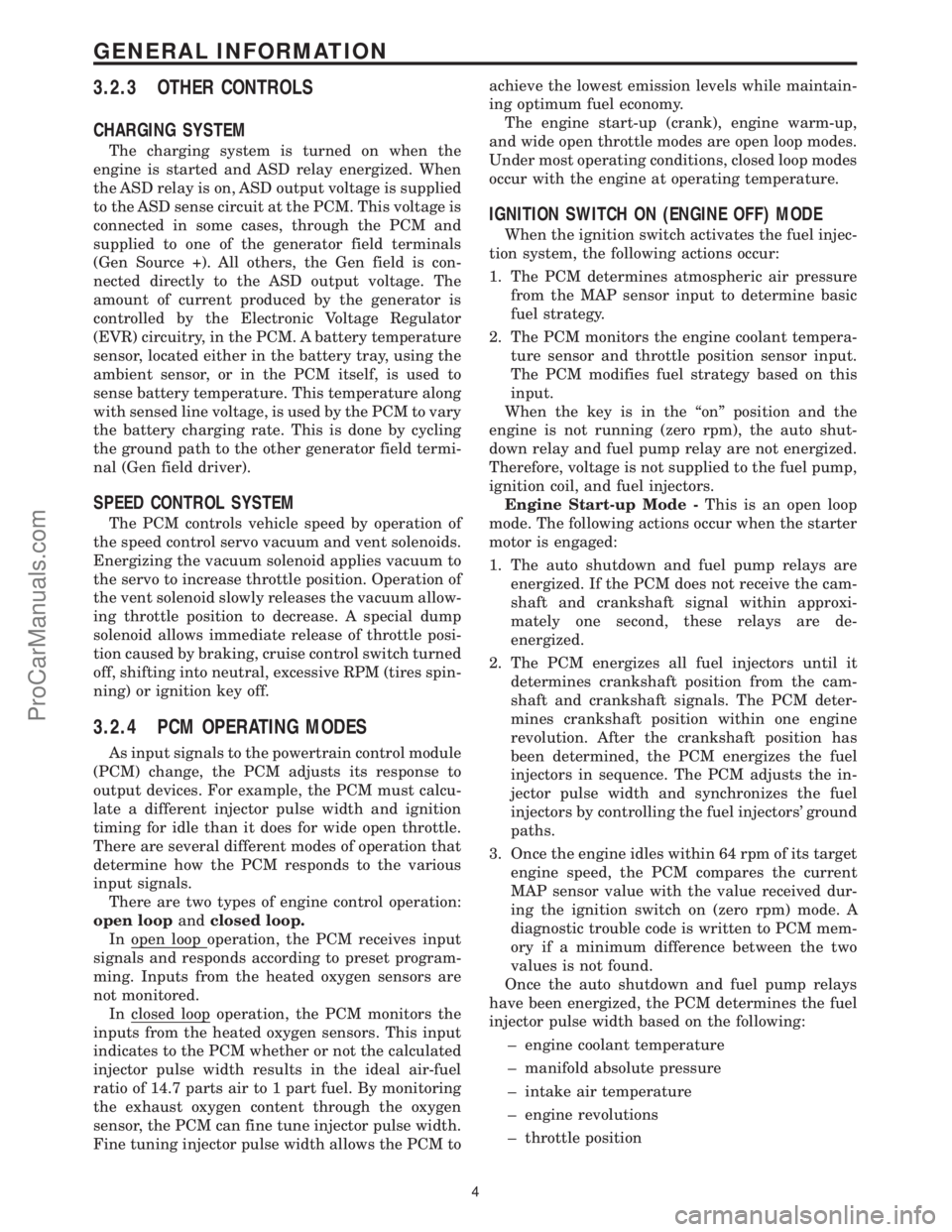
3.2.3 OTHER CONTROLS
CHARGING SYSTEM
The charging system is turned on when the
engine is started and ASD relay energized. When
the ASD relay is on, ASD output voltage is supplied
to the ASD sense circuit at the PCM. This voltage is
connected in some cases, through the PCM and
supplied to one of the generator field terminals
(Gen Source +). All others, the Gen field is con-
nected directly to the ASD output voltage. The
amount of current produced by the generator is
controlled by the Electronic Voltage Regulator
(EVR) circuitry, in the PCM. A battery temperature
sensor, located either in the battery tray, using the
ambient sensor, or in the PCM itself, is used to
sense battery temperature. This temperature along
with sensed line voltage, is used by the PCM to vary
the battery charging rate. This is done by cycling
the ground path to the other generator field termi-
nal (Gen field driver).
SPEED CONTROL SYSTEM
The PCM controls vehicle speed by operation of
the speed control servo vacuum and vent solenoids.
Energizing the vacuum solenoid applies vacuum to
the servo to increase throttle position. Operation of
the vent solenoid slowly releases the vacuum allow-
ing throttle position to decrease. A special dump
solenoid allows immediate release of throttle posi-
tion caused by braking, cruise control switch turned
off, shifting into neutral, excessive RPM (tires spin-
ning) or ignition key off.
3.2.4 PCM OPERATING MODES
As input signals to the powertrain control module
(PCM) change, the PCM adjusts its response to
output devices. For example, the PCM must calcu-
late a different injector pulse width and ignition
timing for idle than it does for wide open throttle.
There are several different modes of operation that
determine how the PCM responds to the various
input signals.
There are two types of engine control operation:
open loopandclosed loop.
In open loop operation, the PCM receives input
signals and responds according to preset program-
ming. Inputs from the heated oxygen sensors are
not monitored.
In closed loop operation, the PCM monitors the
inputs from the heated oxygen sensors. This input
indicates to the PCM whether or not the calculated
injector pulse width results in the ideal air-fuel
ratio of 14.7 parts air to 1 part fuel. By monitoring
the exhaust oxygen content through the oxygen
sensor, the PCM can fine tune injector pulse width.
Fine tuning injector pulse width allows the PCM toachieve the lowest emission levels while maintain-
ing optimum fuel economy.
The engine start-up (crank), engine warm-up,
and wide open throttle modes are open loop modes.
Under most operating conditions, closed loop modes
occur with the engine at operating temperature.
IGNITION SWITCH ON (ENGINE OFF) MODE
When the ignition switch activates the fuel injec-
tion system, the following actions occur:
1. The PCM determines atmospheric air pressure
from the MAP sensor input to determine basic
fuel strategy.
2. The PCM monitors the engine coolant tempera-
ture sensor and throttle position sensor input.
The PCM modifies fuel strategy based on this
input.
When the key is in the ªonº position and the
engine is not running (zero rpm), the auto shut-
down relay and fuel pump relay are not energized.
Therefore, voltage is not supplied to the fuel pump,
ignition coil, and fuel injectors.
Engine Start-up Mode -This is an open loop
mode. The following actions occur when the starter
motor is engaged:
1. The auto shutdown and fuel pump relays are
energized. If the PCM does not receive the cam-
shaft and crankshaft signal within approxi-
mately one second, these relays are de-
energized.
2. The PCM energizes all fuel injectors until it
determines crankshaft position from the cam-
shaft and crankshaft signals. The PCM deter-
mines crankshaft position within one engine
revolution. After the crankshaft position has
been determined, the PCM energizes the fuel
injectors in sequence. The PCM adjusts the in-
jector pulse width and synchronizes the fuel
injectors by controlling the fuel injectors' ground
paths.
3. Once the engine idles within 64 rpm of its target
engine speed, the PCM compares the current
MAP sensor value with the value received dur-
ing the ignition switch on (zero rpm) mode. A
diagnostic trouble code is written to PCM mem-
ory if a minimum difference between the two
values is not found.
Once the auto shutdown and fuel pump relays
have been energized, the PCM determines the fuel
injector pulse width based on the following:
± engine coolant temperature
± manifold absolute pressure
± intake air temperature
± engine revolutions
± throttle position
4
GENERAL INFORMATION
ProCarManuals.com
Page 11 of 364
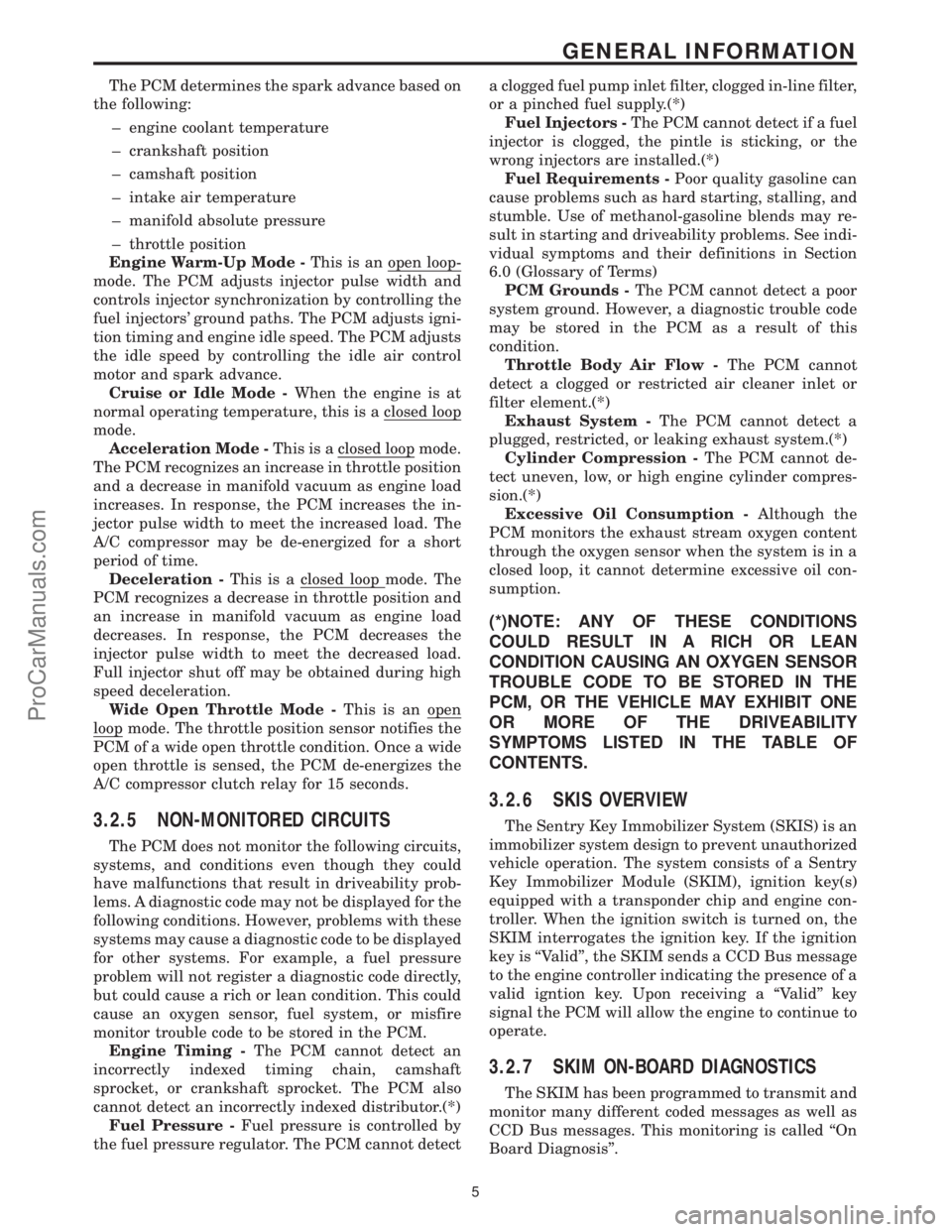
The PCM determines the spark advance based on
the following:
± engine coolant temperature
± crankshaft position
± camshaft position
± intake air temperature
± manifold absolute pressure
± throttle position
Engine Warm-Up Mode -This is an open loop-
mode. The PCM adjusts injector pulse width and
controls injector synchronization by controlling the
fuel injectors' ground paths. The PCM adjusts igni-
tion timing and engine idle speed. The PCM adjusts
the idle speed by controlling the idle air control
motor and spark advance.
Cruise or Idle Mode -When the engine is at
normal operating temperature, this is a closed loop
mode.
Acceleration Mode -This is a closed loop mode.
The PCM recognizes an increase in throttle position
and a decrease in manifold vacuum as engine load
increases. In response, the PCM increases the in-
jector pulse width to meet the increased load. The
A/C compressor may be de-energized for a short
period of time.
Deceleration -This is a closed loop mode. The
PCM recognizes a decrease in throttle position and
an increase in manifold vacuum as engine load
decreases. In response, the PCM decreases the
injector pulse width to meet the decreased load.
Full injector shut off may be obtained during high
speed deceleration.
Wide Open Throttle Mode -This is an open
loop mode. The throttle position sensor notifies the
PCM of a wide open throttle condition. Once a wide
open throttle is sensed, the PCM de-energizes the
A/C compressor clutch relay for 15 seconds.
3.2.5 NON-MONITORED CIRCUITS
The PCM does not monitor the following circuits,
systems, and conditions even though they could
have malfunctions that result in driveability prob-
lems. A diagnostic code may not be displayed for the
following conditions. However, problems with these
systems may cause a diagnostic code to be displayed
for other systems. For example, a fuel pressure
problem will not register a diagnostic code directly,
but could cause a rich or lean condition. This could
cause an oxygen sensor, fuel system, or misfire
monitor trouble code to be stored in the PCM.
Engine Timing -The PCM cannot detect an
incorrectly indexed timing chain, camshaft
sprocket, or crankshaft sprocket. The PCM also
cannot detect an incorrectly indexed distributor.(*)
Fuel Pressure -Fuel pressure is controlled by
the fuel pressure regulator. The PCM cannot detecta clogged fuel pump inlet filter, clogged in-line filter,
or a pinched fuel supply.(*)
Fuel Injectors -The PCM cannot detect if a fuel
injector is clogged, the pintle is sticking, or the
wrong injectors are installed.(*)
Fuel Requirements -Poor quality gasoline can
cause problems such as hard starting, stalling, and
stumble. Use of methanol-gasoline blends may re-
sult in starting and driveability problems. See indi-
vidual symptoms and their definitions in Section
6.0 (Glossary of Terms)
PCM Grounds -The PCM cannot detect a poor
system ground. However, a diagnostic trouble code
may be stored in the PCM as a result of this
condition.
Throttle Body Air Flow -The PCM cannot
detect a clogged or restricted air cleaner inlet or
filter element.(*)
Exhaust System -The PCM cannot detect a
plugged, restricted, or leaking exhaust system.(*)
Cylinder Compression -The PCM cannot de-
tect uneven, low, or high engine cylinder compres-
sion.(*)
Excessive Oil Consumption -Although the
PCM monitors the exhaust stream oxygen content
through the oxygen sensor when the system is in a
closed loop, it cannot determine excessive oil con-
sumption.
(*)NOTE: ANY OF THESE CONDITIONS
COULD RESULT IN A RICH OR LEAN
CONDITION CAUSING AN OXYGEN SENSOR
TROUBLE CODE TO BE STORED IN THE
PCM, OR THE VEHICLE MAY EXHIBIT ONE
OR MORE OF THE DRIVEABILITY
SYMPTOMS LISTED IN THE TABLE OF
CONTENTS.
3.2.6 SKIS OVERVIEW
The Sentry Key Immobilizer System (SKIS) is an
immobilizer system design to prevent unauthorized
vehicle operation. The system consists of a Sentry
Key Immobilizer Module (SKIM), ignition key(s)
equipped with a transponder chip and engine con-
troller. When the ignition switch is turned on, the
SKIM interrogates the ignition key. If the ignition
key is ``Valid'', the SKIM sends a CCD Bus message
to the engine controller indicating the presence of a
valid igntion key. Upon receiving a ``Valid'' key
signal the PCM will allow the engine to continue to
operate.
3.2.7 SKIM ON-BOARD DIAGNOSTICS
The SKIM has been programmed to transmit and
monitor many different coded messages as well as
CCD Bus messages. This monitoring is called ``On
Board Diagnosis''.
5
GENERAL INFORMATION
ProCarManuals.com
Page 12 of 364
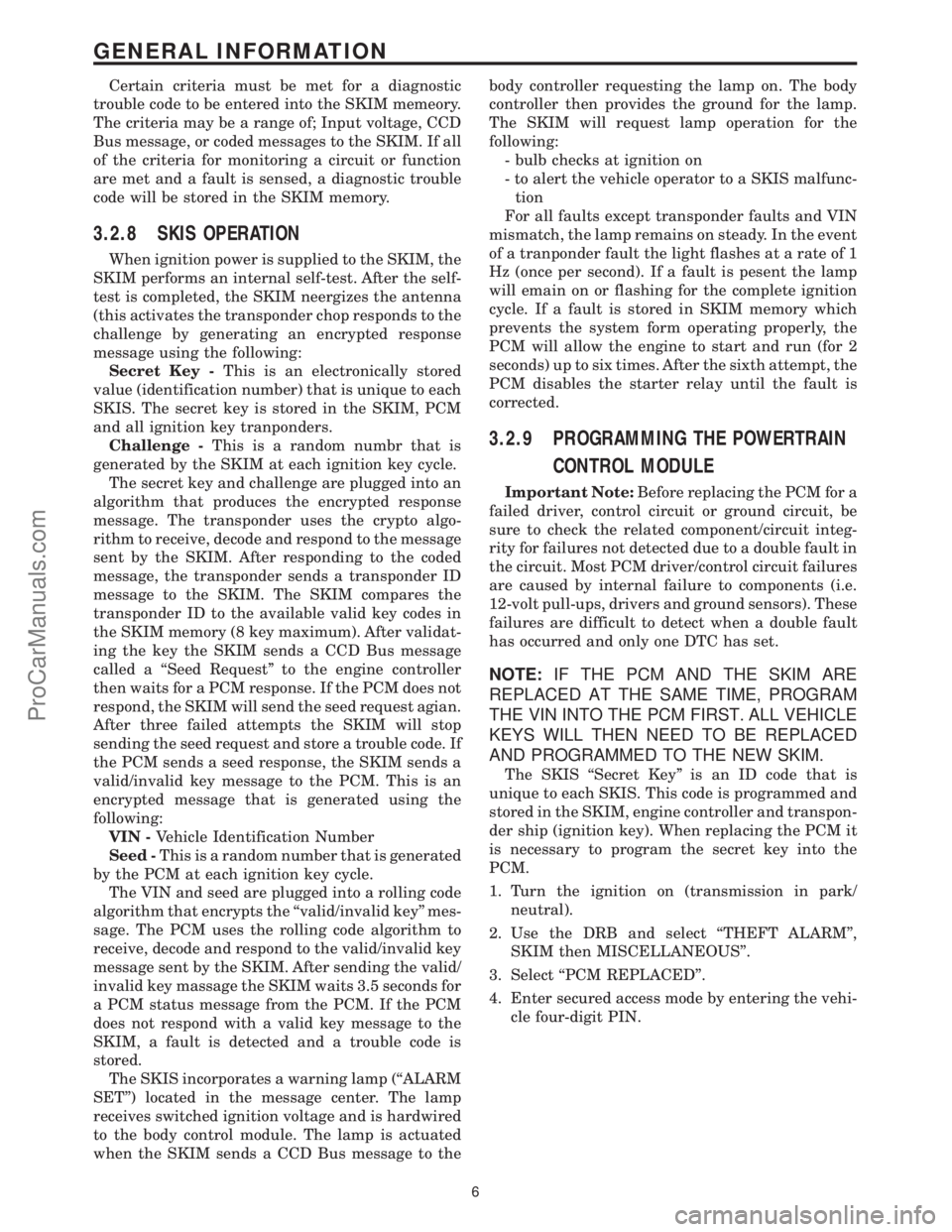
Certain criteria must be met for a diagnostic
trouble code to be entered into the SKIM memeory.
The criteria may be a range of; Input voltage, CCD
Bus message, or coded messages to the SKIM. If all
of the criteria for monitoring a circuit or function
are met and a fault is sensed, a diagnostic trouble
code will be stored in the SKIM memory.
3.2.8 SKIS OPERATION
When ignition power is supplied to the SKIM, the
SKIM performs an internal self-test. After the self-
test is completed, the SKIM neergizes the antenna
(this activates the transponder chop responds to the
challenge by generating an encrypted response
message using the following:
Secret Key -This is an electronically stored
value (identification number) that is unique to each
SKIS. The secret key is stored in the SKIM, PCM
and all ignition key tranponders.
Challenge -This is a random numbr that is
generated by the SKIM at each ignition key cycle.
The secret key and challenge are plugged into an
algorithm that produces the encrypted response
message. The transponder uses the crypto algo-
rithm to receive, decode and respond to the message
sent by the SKIM. After responding to the coded
message, the transponder sends a transponder ID
message to the SKIM. The SKIM compares the
transponder ID to the available valid key codes in
the SKIM memory (8 key maximum). After validat-
ing the key the SKIM sends a CCD Bus message
called a ``Seed Request'' to the engine controller
then waits for a PCM response. If the PCM does not
respond, the SKIM will send the seed request agian.
After three failed attempts the SKIM will stop
sending the seed request and store a trouble code. If
the PCM sends a seed response, the SKIM sends a
valid/invalid key message to the PCM. This is an
encrypted message that is generated using the
following:
VIN -Vehicle Identification Number
Seed -This is a random number that is generated
by the PCM at each ignition key cycle.
The VIN and seed are plugged into a rolling code
algorithm that encrypts the ``valid/invalid key'' mes-
sage. The PCM uses the rolling code algorithm to
receive, decode and respond to the valid/invalid key
message sent by the SKIM. After sending the valid/
invalid key massage the SKIM waits 3.5 seconds for
a PCM status message from the PCM. If the PCM
does not respond with a valid key message to the
SKIM, a fault is detected and a trouble code is
stored.
The SKIS incorporates a warning lamp (``ALARM
SET'') located in the message center. The lamp
receives switched ignition voltage and is hardwired
to the body control module. The lamp is actuated
when the SKIM sends a CCD Bus message to thebody controller requesting the lamp on. The body
controller then provides the ground for the lamp.
The SKIM will request lamp operation for the
following:
- bulb checks at ignition on
- to alert the vehicle operator to a SKIS malfunc-
tion
For all faults except transponder faults and VIN
mismatch, the lamp remains on steady. In the event
of a tranponder fault the light flashes at a rate of 1
Hz (once per second). If a fault is pesent the lamp
will emain on or flashing for the complete ignition
cycle. If a fault is stored in SKIM memory which
prevents the system form operating properly, the
PCM will allow the engine to start and run (for 2
seconds) up to six times. After the sixth attempt, the
PCM disables the starter relay until the fault is
corrected.
3.2.9 PROGRAMMING THE POWERTRAIN
CONTROL MODULE
Important Note:Before replacing the PCM for a
failed driver, control circuit or ground circuit, be
sure to check the related component/circuit integ-
rity for failures not detected due to a double fault in
the circuit. Most PCM driver/control circuit failures
are caused by internal failure to components (i.e.
12-volt pull-ups, drivers and ground sensors). These
failures are difficult to detect when a double fault
has occurred and only one DTC has set.
NOTE:IF THE PCM AND THE SKIM ARE
REPLACED AT THE SAME TIME, PROGRAM
THE VIN INTO THE PCM FIRST. ALL VEHICLE
KEYS WILL THEN NEED TO BE REPLACED
AND PROGRAMMED TO THE NEW SKIM.
The SKIS ``Secret Key'' is an ID code that is
unique to each SKIS. This code is programmed and
stored in the SKIM, engine controller and transpon-
der ship (ignition key). When replacing the PCM it
is necessary to program the secret key into the
PCM.
1. Turn the ignition on (transmission in park/
neutral).
2. Use the DRB and select ``THEFT ALARM'',
SKIM then MISCELLANEOUS''.
3. Select ``PCM REPLACED''.
4. Enter secured access mode by entering the vehi-
cle four-digit PIN.
6
GENERAL INFORMATION
ProCarManuals.com